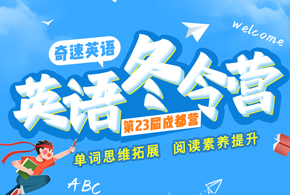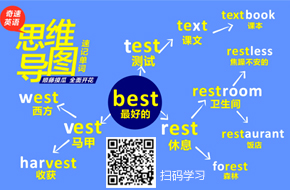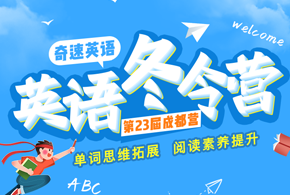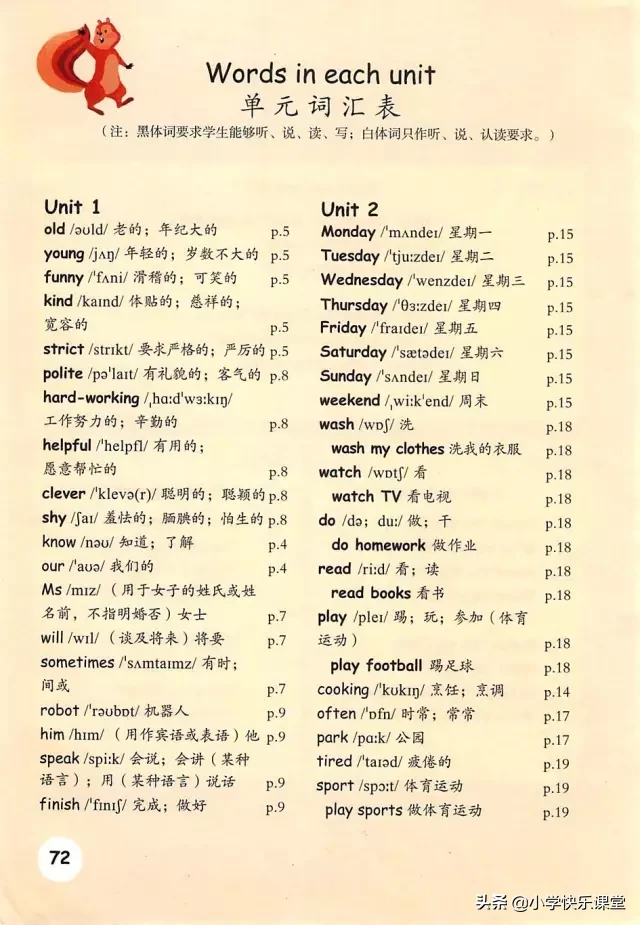
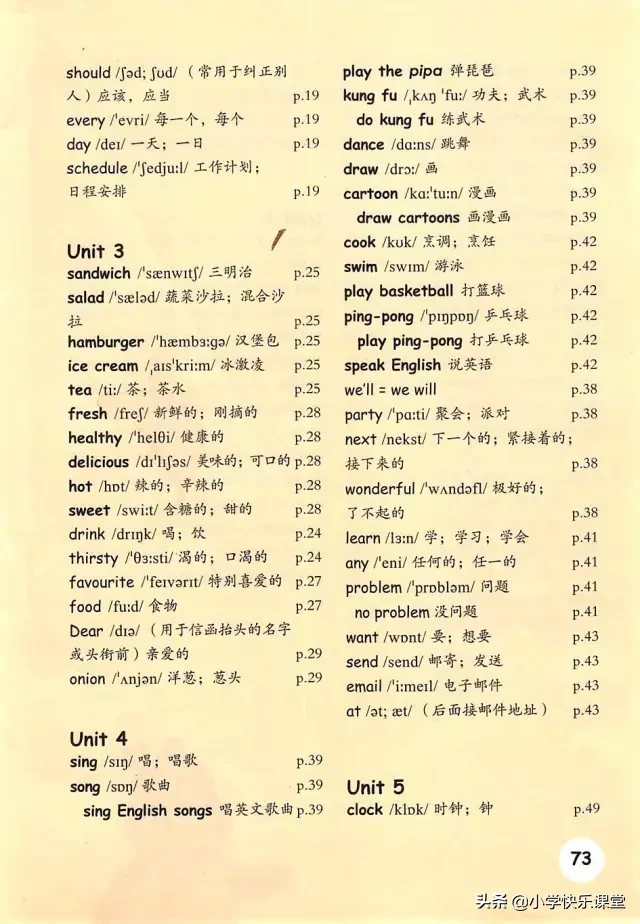
四会单词:(备注:会听、会说、会读、会默写的全面掌握。)
1.Who’s your art teacher?你们的美术老师是谁?
----Yes,she is/No, she isn’t.
I have a new math teacher.
我有一个新数学老师.(小学三年级已经学过I have a pen.)
play computer games 玩电脑游戏
1.What day is it today?今天星期几?
2. What do we have on Mondays?
—We have English,science,computer and P.E.
3.What do you do on Saturdays?
星期六你干什么?(具体的某一天前用介词on,在具体的时间前,用介词at)
—I often do my homework.我通常做家庭作业.
—I do my homework,too.我也是做家庭作业.
1.What would you like for lunch?
-----I'd like some tomatoes and mutton.
2.What's your favourite fruit?
------/I like apples.我喜欢苹果.
3.I don't like grapes.我不喜欢葡萄.
4.Bananas are my favourite.我最喜欢香蕉.
1. I'm helpful! I can sweep the floor。
2. Are you helpful at home?
3. What can you do ? 你会干什么?
------I can sweep the floor.我会扫地。
4. Can you do housework? 你能会家务吗?
------Yes I can.是的,我会 No, I can't,(but I’d like to have a try.)不,我不会,但我想试一试.(括号内的句子可以省略)
1、当你想询问别人会干什么时,用What can you do? 答句I can后面加自己会做的事.
当你想知道他人会干什么时,可用What can he do ? 或者What can she do ? 答语是He can......或者是She can......
2、I can …变为一般疑问句:Can you …?
He can…或She can …变为一般疑问句:Can he …/ Can she …? 其中的he , she 也可以变为其他具体的人物。
如 My mother can cook the meals. 变为一般疑问句:Can your mother cook the meals? 答语有两种:肯定回答Yes,she can.否定回答:No,she can’t.
3、help (形容词形式)---helpful helpful (动词形式)---help
4、当句子中出现了情态动词can或其否定形式can’t时,其他的动词要用原形。
1.Is this your bedroom? 这是你的卧室吗?
2.I have my own room now.现在我有自己的房间了。
------There is a mirror, a bed and a big closet.
(There be句型,某地有某物:There is / are + 家具 )
4.Where is the trash bin? 垃圾箱在哪?
------It's near the table. 它在桌子旁边.
5. The closet is near the table.衣橱在桌子旁边。
6. Many clothes are in the closet. 许多衣服在衣橱里。
1、There be 句型包括单数形式的There is a/an …句型和复数形式的there are …句型。There is a/an …句型表示有一个,后面跟名词单数。There are …句型表示有多个,后面一般接具体数字或some , many,再后面跟名词复数。
There be 句型又叫“存在”句型,它一般表示在某地有某物。
2、There be 句型中使用单数句式还是复数句式遵循就近原则。
over在…上面,表示与下面的物体不接触,两个物体之间有一定的距离。
1.There is a forest in the nature park.在自然公园里有一个森林。
2. Is there a forest in the park? 公园里面有一个森林吗?
------ Yes, there is. 是的,有。No, there isn’t。不,没有。
(There be句型的一般疑问句:--- Is / Are there + 某物 + 某地?回答:Yes, there is / are. No, there isn't / aren't. )
3. There are many small houses in my village. 在我的村庄里有许多小房子。
5.Are there any pandas in the mountains? 山里有熊猫吗?
-----Yes, there are.是的,有/No,there aren’t. 不,没有。
1、There be 的单数形式在变为一般疑问句时,将助动词be提前,与there交换位置,如句中有第一人称代词,变为第二人称,将句末的句号变为问号,其他不变。
There be 的复数形式在变为一般疑问句时,将助动词be提前,与there交换位置,然后将句中some或many变为any, 如句中有第一人称代词,变为第二人称,再将句末的句号变为问号,其他不变。
2、There be 句型表示“有”和have, has表示“有”的区别
There be句型表示“有”的意思,表示在某个地方有什么,它表示的一种存在。
如:There is a bag on the desk. 有一个书包在课桌上。
There are many books on the desk. 有许多书在课桌上。
Have, has 表示“有”的意思,表示一种占有,拥有的关系,一般表示某人有某物。当主语人称是第三人称单数时用has, 其他时候用have。如:I have a new pen. 我有一支新钢笔。
He has a big schoolbag. 他有一个大书包。
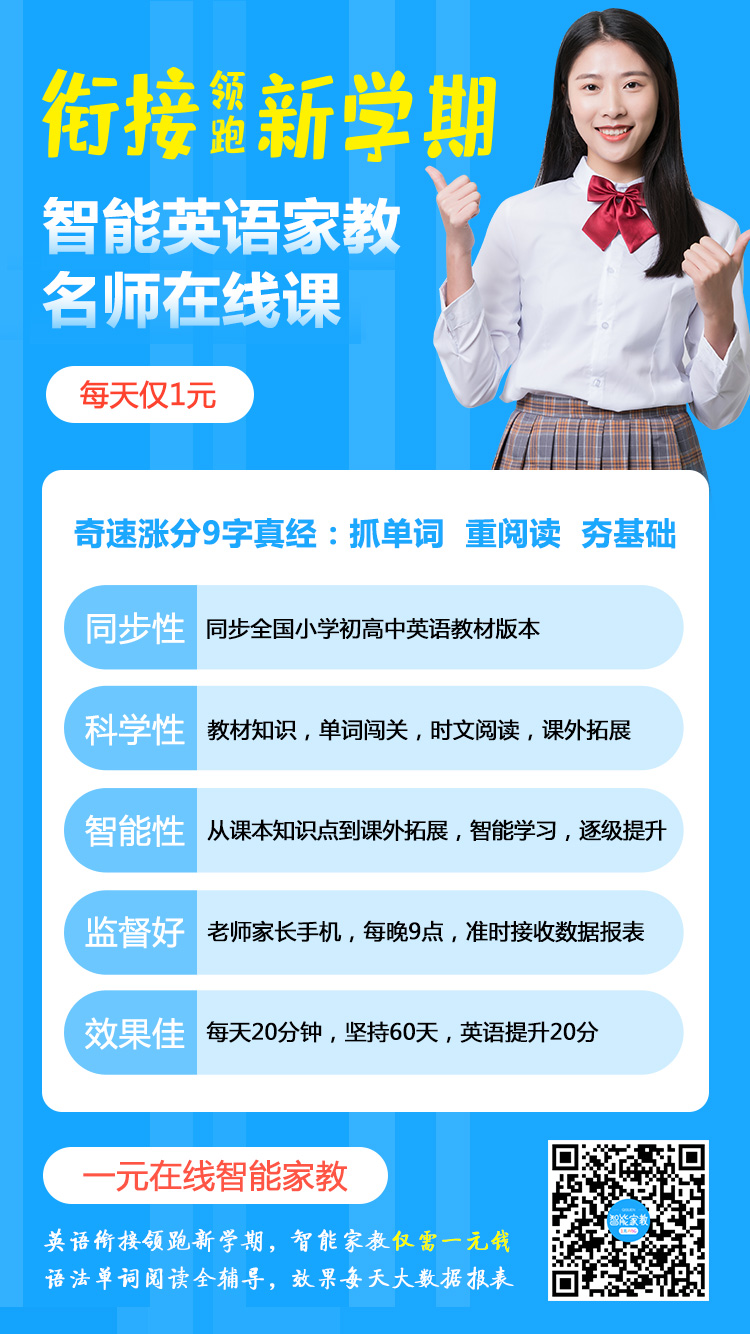
长按识别二维码 每日仅需1元学
文章来源于网络 版权归原作者所有
如有侵权请联系删除




